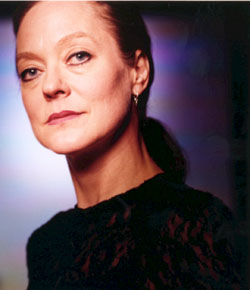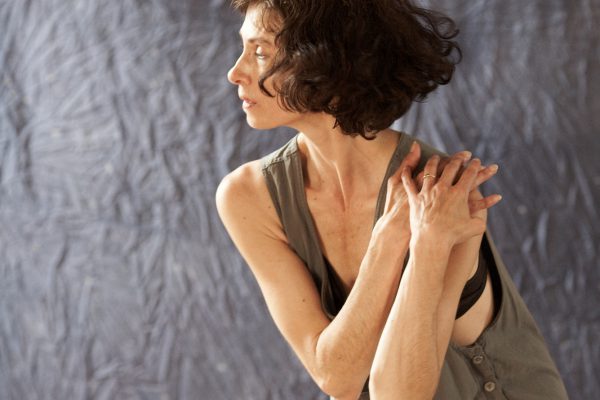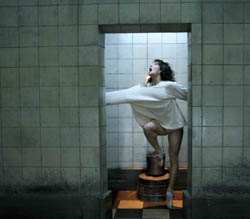Just how deep does the damage go? In SHINY Kelly McInnes gets to the guts of this question in a persistent and stealthy topic: the effects of the beauty standards inflicted on women through media.
The stage at KW Production Studio is set to resemble a beauty parlour, with a high stool, a full-length mirror and a sewing table. Fashion magazines are all over the place — hanging from the ceiling and covering the floor in makeshift quilts. Two women are initially visible: McInnes reads Vogue at the foil-covered sewing table, and Maggie McGhee is perched on the stool, facing upstage, her long grey hair cascading down her back.
When McInnes begins to stitch together her reading materials, the gentle thrum of the sewing machine fills the small theatre. McGhee gently undresses, pinning her white costume to a clothesline overhead. Piece by piece she unpins a new costume from the line, creating a laminated magazine “skin suit” to cover her naked body like armour. Each time she pulls on a section, she displays it seductively to the audience for admiration. Just before she pulls on the last piece (a helmet featuring dozens of digitally manipulated female faces), her expression freezes into a wide and dead-eyed smile. Then she pulls it down and disappears.
The VIDF program describes McInnes’s work as inviting the audience’s attention to sensation and, in that vein, I immediately noticed the uncomfortable feeling of plastic against bare skin. Throughout the work the performers’ naked and sweating bodies are pressed and pinched against plastic, packing tape and paper so visibly it is difficult to not flinch. Yet their relationships to each prop is uncertain: is it an enviable fashion object or an engulfing force? Covered in magazine armour, McGhee seems to transform into some kind of savage Vogue goddess of beauty — pulling a whimpering Luciana D’Anunciação toward her and stroking her hair with gnarled fingers.
SHINY uses hysteria to quickly dive through pretense to get at the disgust, pain and intensity of McInnes’s subject. Amidst all the bare skin, plastic and paper, the women underneath the costumes remind us of their presence through vocalizations and physical displays that emote with force. Early in the work, D’Anunciação shifts between model poses downstage, chuckling gently from behind a magazine helmet. Her quiet chuckle builds slowly to shrill laughter and then finally to full-belly screeches that lead her blindly around the stage, bumping into objects, falling and grasping for balance.
Later, McGhee writhes and wrangles with magazines under low light, emitting deep guttural moans as she slowly rips herself out of her skin suit. When she begins to name body-modification treatments (“face lift, tummy tuck, liposuction …”), she uses packing tape to tape-lift various parts of her bare skin, looking in the mirror for approval. The work builds to a climax when McInnes takes apart a paper shredder and eats, buries her face in and throws magazine shreddings around the stage, laughing so contagiously that most of the audience joins in. Behind her, D’Anunciação compulsively vacuums up shreddings and anything she sees (including her own skin) while muttering affirmatives — “Yes, of course, definitely, uh-huh.”
These hard-hitting vignettes are captivating until the very last moment. At the end of the work, the three dancers (nude again) are buried under one large magazine quilt that moves upstage like an amoeba and then slowly reveals their faces. Fake smiles begin to twitch and fade. For the first time, the performers look like themselves, staring out at the audience. In a profound instant, they turn to notice each other for the first time. Behind them, dozens of hand-held mirrors sway delicately from invisible wire upstage, glinting as they catch the light. Amidst all the shiny objects, we are surrounded with a glaring absurdity: that every person should fit into the same box.
Tagged: Contemporary, BC





